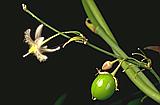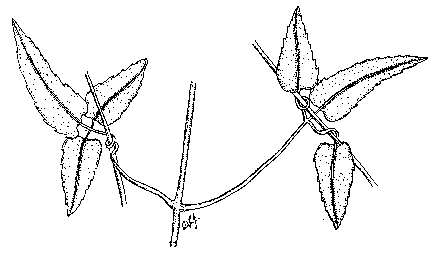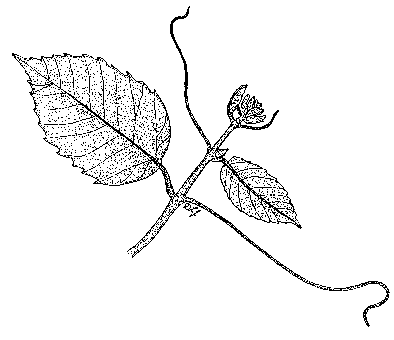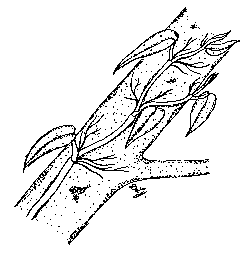|
[Front Page] [Features] [Departments] [SGAP Home Page] [Subscribe]

Australian Climbing Plants
Rodger Elliot
Notes from a talk given by Rodger Elliot to the November 1990 Regional Meeting of the New South Wales Region of SGAP. Rodger has kindly reviewed and updated the material which was transcribed by Jim and Wilma Thompson.
Introduction
Probably most people grow climbers. Some grow them on trellises; others let them grow on the ground. But have you ever tried to define just what is a climber? It's a term given to plants which tend not to be shrubs and which are not trees. They are usually herbaceous perennials. They tend not to have strong stems which permit other plants to stand independently of support. They are plants which are fairly supple and which like to go their own way.
There are a whole range of terms used to describe different types of climbers...trailers, vines, lianes, creepers, ramblers, ground covers. What I'd like to do is describe some of the different types and make some general comments on how to grow them.
But before we look at some of the variety among Australia's climbers, have you ever considered what makes plants climb? Charles Darwin studied this aspect of plant growth and one of the plants that he chose to study was the West Australian Sollya heterophylla. He found that on a cool day Sollya took about eight hours to make one complete revolution around a stake. On a warm day the time was reduced to four and a half hours.
 |
Clematis aristata is a common climbing plant of east coast eucalypt forests. Select the thumbnail image or plant name for a higher resolution image (30k).
|
It's also interesting to note that he observed, in the Southern Hemisphere, climbers twine anti-clockwise. In the Northern Hemisphere the direction of twining is reversed...it's a bit like water going down the hole in a sink!
Australia has about 400 climbing species which is not a large number in comparison with other parts of the world. The main development of Australian climbers is in the rainforests. There is tremendous diversity in those regions but climbers also occur right across Australia. You'll even find a small range of climbers among the desert plant communities.
The best development of Australian climbers is among the woody plants but there are also some lilies which climb. These include Thysanotus patersonii, the "Climbing Lily", Eustrephus latifolius, the "Wombat Berry" and Geitonoplesium cymosum.
 |
The new fruits of the wombat berry, Eustrephus latifolius turn bright orange when ripe and contain numerous black seeds. Select the thumbnail image or plant name for a higher resolution image (15k).
|
Families of Australian Climbing Plants
Some of the families we have in Australia include the so-called "Dutchman's Pipe" group, the Aristolochiaceae, which occur mainly in the north. We also have quite a few members of the cucumber and grape families. Cissus antarctica is probably the best known of the latter group.
In the Myrtle family there a few that climb but there are no climbers among the Proteaceae.
In the Palm family there is the genus Calamus, the "Lawyer Vines". If you've ever been in the rainforest in shorts and you come across Calamus you'll know about it and know why it's also called "Wait-a-While"! There are also climbers in the Pandanaceae, the Pandanus family.
There are also climbing grasses (Tetrarrhena is one that can be found around the Sydney area) and a couple of species of climbing bamboo. Bambusa moreheadiana can have stems to about 70 metres long up in the rainforest.
 |
The genus Billardiera has many species worthy of cultivation including the spectacular Billardiera erubescens. Select the thumbnail image or plant name for a higher resolution image (28k).
|
In the woody, dicotyledonous plants, the pea family has the largest number of climbers...about 88 species. In the Pittosporaceae (Pittosporum family), the genus Billardiera has about 28 different species and is probably the largest genus of Australian climbing plants.
How Climbers "Climb"
I suppose most of us know about twining climbers but there are a number of other methods involved.

Coiled leaf stalks of Clematis aristata
As the name suggests, leaf climbers use their leaves or part of their leaves to attach themselves to other things. Clematis species are in this category. If you look closely how they attach onto other plants or onto trellises you'll find that the leaf stalk curls around the support or around other stems. Other leaf climbers tend to use the stiffness of their horizontal leaves to support themselves as they work their way up. Gompholobium venustum from Western Australia is in this category. Even the well known Chorizema cordatum and Brachyscome multifida (see below) sometimes act as climbers in this way.
A number of species have special tendrils that twine or wrap around other objects. Passiflora is a familiar member of this group and Cissus species do the same.

Spreading tendrils on a young shoot of Cissus artarctica
Hook climbers include Calamus (that I've already mentioned) and Smilax. The ends of the leaves of Smilax have hooks which can attach themselves to other plants. Some Drosera species (Sundews) are similar. They don't actually have hooks but sticky hairs that act like hooks. They tend to latch onto other plants and climb upwards until they reach light and then flowering occurs.

Root climber showing growth habit
Root climbers are another group. There are three orchids that I know of that climb in this way; their roots penetrate the bark of trees as they work their way upwards. Examples include Erythrorchis cassythoides (syn. Galeola cassythoides) and Pseudovanilla foliata (syn. Galeola foliata). There is also Rhaphidophora, a genus of extremely vigorous rainforest climbers with great potential for indoor cultivation.
Then we have a group which are called sub-climbers. They don't actually twine themselves but they throw out long shoots which get caught up in the branches of other plants. Some Pandorea species do this, although some will twine also. P.jasminoides is a good example of a sub-climber as are some of the Jasmines. J.calcareum is one that tends to act as a shrub but, if it is near a suitable plant, it will climb. The jasmines have a beautiful perfume.
There are also some plants which are not usually recognised as being climbers but which, under certain conditions will work their way up. Even the little "Cut-Leaf Daisy", Brachyscome multifida, will do this in a shady spot if it has some other plants to work its way through. It will get up to 2 or 3 metres high in some cases.
Hibbertia empetrifolia is similar. I know of one which is nearly 4 metres off the ground. A few others that will do this sort of thing include Correa reflexa, C.alba, C."mannii", Prostanthera monticola, Lechenaultia macrantha and some Thomasia species.
Climbers in the Garden
How can we use climbers in the garden? We can obviously learn a lot from observing how they grow in nature.
Most Australian climbers need some form of support if they are to grow well in cultivation. So what generally happens is that people put up some form of trellis or wire support and this can be a very useful method if a quick screening plant is required.
However, it is worth considering a more natural way of using climbers by letting them wander through other plants. There are many Australian climbers which are not overly vigorous which are ideal for this purpose but you need to be selective. If you try this with Kennedia nigricans, K.retrorsa or K.rubicunda you'll find that not only will other plants in the garden be swamped but your fence may also be overcome and end up lying horizontal! I've seen K.nigricans kill a forest oak (Allocasuarina torulosa) just by smothering it.
 |
A number of the kennedias, such as Kennedia rubicunda can become excessively vigorous in the garden. Select the thumbnail image or plant name for a higher resolution image (35k).
|
One should be wary of cultivating Sollya heterophylla. In Victoria it has become a bit of a disaster; it really tends to take over. There are a few Australian climbers that can become weedy very quickly as they have seeds that birds like to eat or the seeds are dormant for long periods. Another one causing some problems is Kennedia rubicunda which is native to areas of the east coast.
Propagation
A lot of climbers can be grown from seed. Some, however need special treatment. The pea-flowered plants are in this category and it's necessary to break down the hard outer coating to allow water to penetrate. There are various methods of doing this and I'm sure most of you are familiar with them (soaking in near boiling water or rubbing the seed with sandpaper are the most commonly used methods).
Seed of many species, however, doesn't need treatment at all and germinates readily using conventional methods.
One thing to keep in mind if you're growing tropical species is that the seed of these often has a short viability period. So, its a good idea to make sure that their seed is sown while still fresh.
Many climbers will also grow well from cuttings. It has been found that a lot of the vigorous climbers don't need to have a basal node. This goes against the usual propagation advice in books that you should always cut just below where the leaves join the stem because this produces a "basal node" from which roots develop. With plants like Kennedia, Pandorea and Hardenbergia you can make the basal cut between the nodes (an "internode") and get extra cuttings from the one piece of stem. Actually, with a number of species we have found that we get better results without basal nodes. So, what you should do is experiment a bit; try some with a basal node and some without. Even try leaf cuttings. You may come up with some good results.
Billardiera is one genus that can be quite difficult from seed but generally strikes well from cuttings. The seed of some species seems to have an inhibitor. Seeds of B.scandens and B.longiflora usually germinate, albeit sporadically; they are best sown in autumn. We tried to germinate species such as B.drummondiana for years without success and then, after several years, two seeds germinated. So, don't throw out seedling trays just because nothing seems to be happening and, if you do succeed in germinating seed of Billardiera, let us know because it's important information.
Rodger Elliott is well known to most people interested in the Australian flora through his long involvement in the propagation and cultivation of Australian plants, as well as through his writing and lecturing. His major project since the late 1970s has been as co-author, with David Jones, of the "Encyclopaedia of Australian Plants", seven volumes of which have now been published.
The diagrams showing climbing mechanisms are by David Jones and are taken (with permission) from "Australian Climbing Plants" by David Jones and Bruce Gray (1977).

[Front Page] [Features] [Departments] [SGAP Home Page] [Subscribe]
Australian Plants online - March 1998
The Society for Growing Australian Plants
|